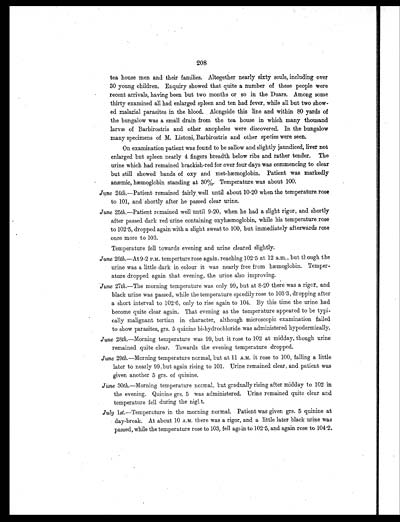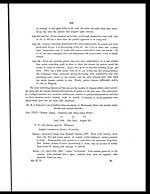Medicine - Institutions > Army health reports and medical documents > Scientific memoirs by officers of the Medical and Sanitary Departments of the Government of India > Number 35 - Black-water fever > Part VI
(220) Page 208
Download files
Individual page:
Thumbnail gallery: Grid view | List view

208
tea house men and their families. Altogether nearly sixty souls, including over
30 young children. Enquiry showed that quite a number of these people were
recent arrivals, having been but two months or so in the Duars. Among some
thirty examined all had enlarged spleen and ten had fever, while all but two show-
ed malarial parasites in the blood. Alongside this line and within 80 yards of
the bungalow was a small drain from the tea house in which many thousand
larvæ of Barbirostris and other anopheles were discovered. In the bungalow
many specimens of M. Listoni, Barbirostris and other species were seen.
On examination patient was found to be sallow and slightly jaundiced, liver not
enlarged but spleen nearly 4 fingers breadth below ribs and rather tender. The
urine which had remained brackish-red for over four days was commencing to clear
but still showed bands of oxy and met-hæmoglobin. Patient was markedly
anæmic, hæmoglobin standing at 30%. Temperature was about 100.
June 24th.—Patient remained fairly well until about 10-20 when the temperature rose
to 101, and shortly after he passed clear urine.
June 25th.—Patient remained well until 9-20, when he had a slight rigor, and shortly
after passed dark red urine containing oxyhæmoglobin, while his temperature rose
to 102.5, dropped again with a slight sweat to 100, but immediately afterwards rose
once more to 103.
Temperature fell towards evening and urine cleared slightly.
June 26th.—At 9-2 P.M. temperture rose again, reaching 102.5 at 12 a.m., but though the
urine was a little dark in colour it was nearly free from hæmoglobin. Temper-
ature dropped again that evening, the urine also improving.
June 27th.—The morning temperature was only 99, but at 8-20 there was a rigor, and
black urine was passed, while the temperature speedily rose to 103.3, dropping after
a short interval to 102.6, only to rise again to 104. By this time the urine had
become quite clear again. That evening as the temperature appeared to be typi-
cally malignant tertian in character, although microscopic examination failed
to show parasites, grs. 5 quinine bi-hydrochloride was administered hypodermically.
June 28th.—Morning temperature was 99, but it rose to 102 at midday, though urine
remained quite clear. Towards the evening temperature dropped.
June 29th.—Morning temperature normal, but at 11 A.M. it rose to 100, falling a little
later to nearly 99, but again rising to 101. Urine remained clear, and patient was
given another 5 grs. of quinine.
June 30th.—Morning temperature normal, but gradually rising after midday to 102 in
the evening. Quinine grs. 5 was administered. Urine remained quite clear and
temperature fell during the night.
July 1st.—Temperature in the morning normal. Patient was given grs. 5 quinine at
day-break. At about 10 A.M. there was a rigor, and a little later black urine was
passed, while the temperature rose to 103, fell again to 102.5, and again rose to 104.2.
Set display mode to: Large image | Zoom image | Transcription
Images and transcriptions on this page, including medium image downloads, may be used under the Creative Commons Attribution 4.0 International Licence unless otherwise stated. ![]()
| Permanent URL | https://digital.nls.uk/75060902 |
|---|
| Description | Appendix |
|---|
| Shelfmark | IP/QB.10 |
|---|---|
| Additional NLS resources: | |




